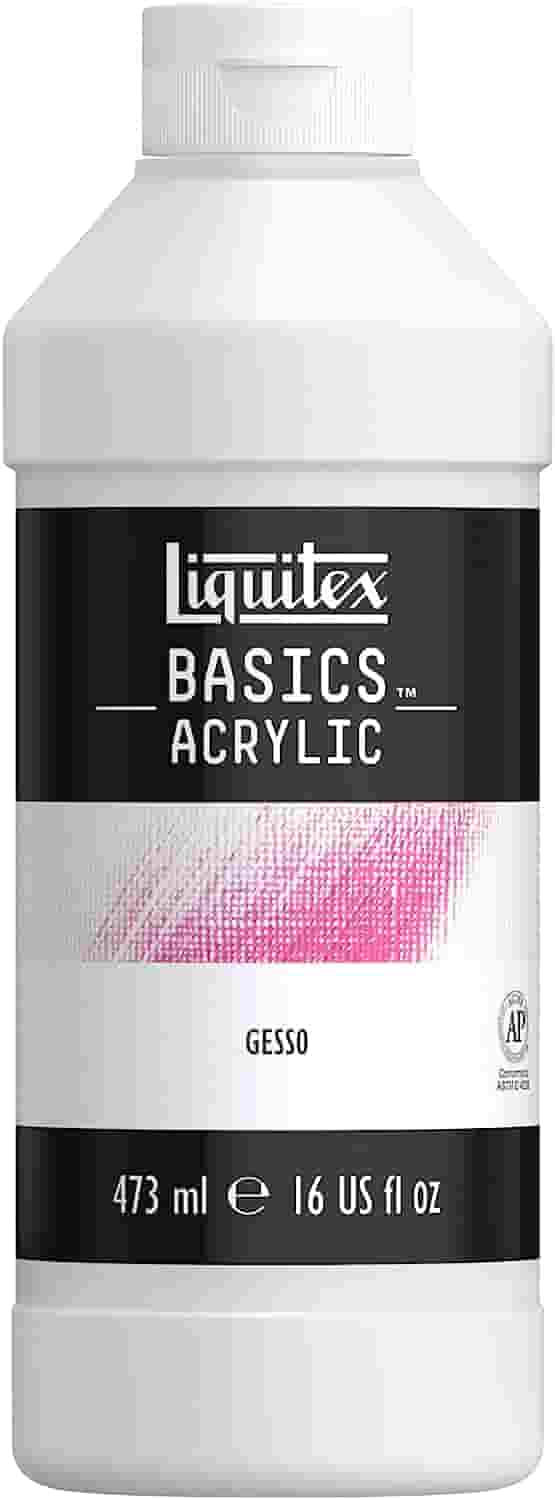Are you making oil paintings and facing the issue of gesso cracking? Gesso is a primer that is used to protect the surface of a painting. It provides a smooth surface for the painting and also maintains the quality. Sometimes gesso does not apply properly and gets cracked which causes the painting to look bad.
In this blog, we will deliver the reasons behind the gesso cracking and some solutions to solve this issue. We will go into the world of gesso and find the solution to “Why is gesso cracking?”
Let’s explore!
Table of Contents
- Gesso layers are thick
- Not proper drying time
- Excessive Use of Water with Gesso
- Not using good quality gesso
- Not maintaining proper temperature
- You are not matching the surface and gesso
- The Solution to Prevent Gesso from Cracking
- Should you use water with gesso?
- How do you keep gesso from cracking?
- Does gesso prevent cracking?
- How many times should you apply gesso?
- FAQs
- Final Words
Why is my gesso cracking?
Your gesso is cracking most commonly because you are not layering gesso properly but there could be some other reasons such as using water with gesso, not maintaining suitable temperature, not giving proper drying time or your gesso is extra thick.
Here is a list of these reasons:
- Gesso layers are thick
- Not giving a proper drying time
- Using water with gesso
- Not using good quality gesso
- not maintaining a proper temperature
- Not matching the canvas surface and gesso
Read Also: How to make gesso at home?
Notice Title
This section contains some products with affiliate links. Buying through our links won’t cost you extra charges but we may receive some commission. Know more about our Review Policy here.
Recommended Gesso

Liquitex BASICS Gesso Surface Prep Medium, 473ml (16-oz) Bottle, White
- High-quality base coat primer
- For oil & acrylic
- Safe for educational use
- Amazon’s Choice
- Easy to use & handle
- Easy to spread
- Highly durable
About Liquitex Gesso:
Liquitex BASICS Gesso is made for both acrylics and oil painting surface preparation. It is also easily mixable with any professional acrylic paint color and medium. It has a moderate consistency that does not require any additional materials to make it thinner or thicker. In other words, it is useable directly after opening the bottle. Other primers require two to three coats but Liquitex gesso just needs to be coated only one time above the surface.
At the time of publication, the item had a total of 8000 ratings with an average rating of 4.7/5 stars. The seller of this item is also declared as the Best Seller on Amazon. The listed bottle of Liquiitex Gesso comes in a size of 16 fl o-z which is really value for money as compared to other brands.
Features:
Brand: Liquitex | Item Volume: 200 Milliliters | Age range: Adult | Useable for: Oil & Acrylic | Product Dimensions: 2.72 x 2.72 x 3.7 inches
Price at the time of publishing: 15.98$
Our Rating: 4.7 Star Out of 5
What We Like!
- Best Seller
- Durability
- For both Oil & Acrylics
- Brand Popularity
- Good coverage
What We Don’t Like
- It is white but dries clear that can make you nervous
Gesso layers are thick
Quantity is the most important part when you make an oil painting. A large amount of items or less amount of items affects your oil painting directly. So applying a thick layer of gesso may cause gesso cracking. Use a neutral amount of gesso layers on your oil painting.
If you don’t know how to create a thin layer, practice creating a thin and balanced layer on paper. If you apply a thick layer of gesso on your oil painting then it may be possible outer layer to get dry but the internal layer may not dry and that may cause gesso cracking.
Not proper drying time
Before applying the painting layer, check whether the gesso dries properly or not. If the surface is not fully dry and you are applying the next layer on it then it will cause cracking.
Provide proper time to let the gesso dries completely because the inner layer needs some air and time. The normal time to dry the gesso is 24 hours.
Excessive Use of Water with Gesso
Using excessive water with gesso, especially in oil painting is also a common reason behind the cracking of gesso. As acrylic gesso is water-based, so there is no need to add additional water to decrease the thickness. Instead of using water, use a small amount of water.
As gesso is famous for acrylic painting in which we can use water anywhere, beginners often try to use water with gesso in oil painting due to insufficient knowledge which is also the major cause behind the cracking of gesso.
Not using good quality gesso
Quality also matters the same as quantity in oil painting. The low quality of gesso affects its shelf life and crack. Good quality gesso has a long shelf-life and is also good to protect against cracks. In the low-quality gesso, it may be taken a high risk of cracks and dry timing and may not be for every surface.
Use a good quality gesso of well-known brands such as Liquitex acrylic gesso.
Not maintaining proper temperature
65 to 70 degrees Fahrenheit is a favorable temperature for gesso as well as oil painting. A sudden change in temperature due to weather changes or any other environmental issues can also become a reason for the cracking of gesso.
Sometimes, artists leave the heater turned on in the room, which can easily affect the gesso layer. Placing a gesso in front of a fire can also ruin its quality. Use suitable places such as store rooms to store it.
You are not matching the surface and gesso
The surface and the type of gesso must match each other if you are applying gesso over the canvas. Sometimes, beginners often use surfaces instead of canvas and wooden boards that don’t let the gesso settle down very well over the surface. After months, it starts to peel off the surface which is heartwarming. So, avoid this mistake.
The Solution to Prevent Gesso from Cracking
- Apply moderate layers of gesso not very thin nor very thick
- Give a proper drying time of 24 hours
- Don’t use water in oil painting
- Use good quality gesso
- Maintain a temperature between 60 to 75 degrees Fahrenheit
- Match the surface of gesso and canvas properly and additionally use a canvas or any other suitable surface
Should you use water with gesso?
Yes, you can put water in the gesso but only one condition when you see the gesso consistency is much thicker because the gesso is already water-based and there is no need to add additional water in most cases.
We would recommend avoiding using additional water in gesso as you are doing oil painting.
How do you keep gesso from cracking?
The first layer of the gesso must be thinner and you must have to dry the first layer. Practice a clean and ventilated environment around the room where dust cannot come in contact with the canvas surface. Also, make sure to clean the surface before applying gesso.
Make sure that you are using a good quality gesso and providing a suitable temperature to the gesso layer. Use a soft brush to apply the gesso layer over the surface to avoid any imbalance. Additionally, place it in a proper storing place where temperature fluctuation is minimum.
Does gesso prevent cracking?
Gesso directly does not protect from cracking but it works as a carpet of a floor that makes the surface suitable for guests instead of a bumpy concrete floor. So, yes the gesso can prevent cracking. Instead of cracking, there are so many other advantages of using gesso that you may want to read: Benefits of white and black gesso.
How many times should you apply gesso?
Applying a single coating of gesso is not enough in most cases so you have to apply at least double and maximum triple coating. Make sure to give a proper time to dry the gesso between layers.
FAQs
Is two-layer gesso enough?
Yes, two-layer gesso is enough to prime a surface very well. In most cases, artists often recommend newbies to prime double coating of gesso.
Does Gesso crack over time?
Yes, gesso cracks over time, most probably after drying. Most commonly, it cracks due to over-fluctuation in temperature, additional water, cheap quality brands, and the extra thickness of the gesso layer.
Final Words
Gesso is just a magical thing that can increase the quality of oil paintings. No doubt, using gesso is easy but there are so many minor things that cause the gesso to crack over time. Gesso cracks due to excessive use of water, not using a suitable surface, applying thick gesso layers, not giving proper time to dry, and not maintaining a proper temperature.
By overcoming all the main causes, we can give a boost to the shelf life of gesso. Cracks over the oil paints can easily be restored but restoring cracks of gesso is not easy to restore and that also causes cracks on the upper layers. That’s to handle carefully with gesso and read proper guidelines about gesso to understand its working and use.
Read More:
